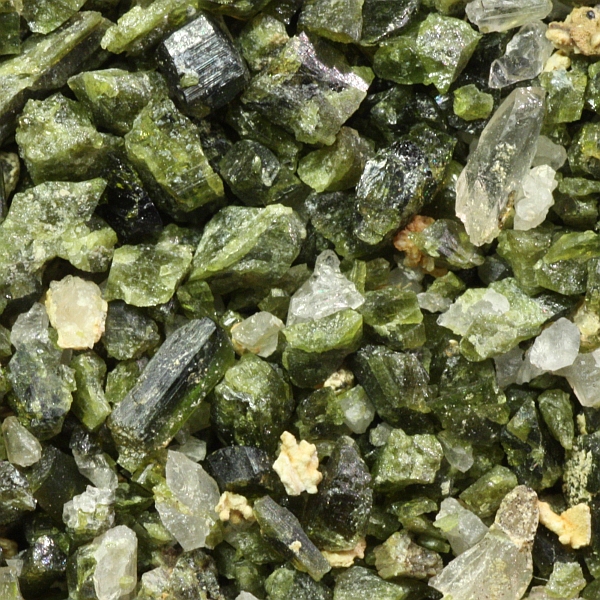Epidote is a common pistachio-green silicate mineral. This light-green color helps to distinguish it from chlorite, which may occur with it but is usually darker green. However, epidote may have various shades of green color, larger crystals are almost black.
http://picasaweb.google.com/107509377372007544953/2015#6190953243943825010
With quartz, actinolite and pumpellyite (bluish in lower left). Width of sample from Norway is 9 cm.
Epidote is a mineral, but there are other structurally similar minerals which together are known as the epidote group. Hence, it has both wider and narrower meanings. Other minerals of the group are clinozoisite, zoisite, allanite and piemontite. Epid. is the most common of these minerals and forms a solid solution series with clinozoisite. Clinozoisite can be described as epidote without or with little iron content. Zoisite shares the same composition with clinozoisite but has a different crystal structure. Zoisite is not as common as clinozoisite. Allanite contains rare earth elements and piemontite is a relatively rare form of reddish variety that contains manganese.
http://picasaweb.google.com/107509377372007544953/Coll#5850292525916741042
Sand-sized crystals demonstrate that it forms elongated crystals. Width of view 38 mm. Nevada, USA.
http://picasaweb.google.com/107509377372007544953/Rocks#5786993618287563826
Hydrothermal vein in a granitic rock. There is a crack in the middle which allowed the hydrothermal fluids to flow and metamorphose the rock. The assemblage of epidote with pink K-feldspar and quartz is also known as unakite. Width of sample 11 cm. Arendal, Norway.
This mineral occurs mostly in various metamorphic rocks (greenschist and amphibolite facies), but it may also crystallize directly from felsic magma. In metamorphic rocks it forms at the depth of 5…25 km and temperature between 300…650°C. It also occurs in blueschist facies rocks and in metamorphosed carbonates. It is widespread in metamorphic rocks. Epidote is a very common hydrothermal alteration mineral. This alteration process, if it happens with feldspars, is known as epidotization. Saussuritization is a hydrothermal alteration of plagioclase feldspar which yields epidote. It is usually found in mafic igneous rocks.
http://picasaweb.google.com/107509377372007544953/2015#6190951741797458962
Epidotic alteration on a gneiss boulder. Varanger Peninsula, northern Norway. Width of sample 15 cm.
It is pretty resistant to weathering and is therefore common mineral in sediments. The heavy mineral fraction of sands very typically contains green epidote grains with black magnetite and pink almandine garnet. However, there could be many different green-colored minerals in sand which seriously complicates the identification. Green minerals may also be olivine, pyroxene, chlorite, pumpellyite, etc.
http://picasaweb.google.com/107509377372007544953/Cyprus2#5752041155700155106
Epidosite is a rock type that contains lots of epidote. The specimen from Cyprus (Troodos ophiolite) is about 10 cm in width.

Sand-sized grains from a mine in Nevada, USA.
Leave a Reply